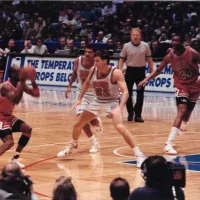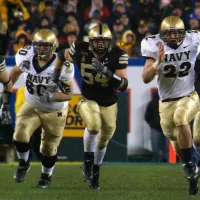The Pac-12 Conference is a collegiate athletic conference in the Western United States that participates in NCAA Division I, with its football teams in the FBS. Currently, it comprises only two members: Oregon State University and Washington State University.
1916: PCC Begins Play
In 1916, the Pacific Coast Conference (PCC) officially began play.
1918: Stanford Joins the League
In 1918, Stanford University joined the Pacific Coast Conference (PCC).
1922: PCC Expands to Eight Teams
In 1922, USC and Idaho were admitted, expanding the Pacific Coast Conference (PCC) to eight teams.
1924: Pac-12 School Leads Summer Olympic Games - Since 1924
Since 1924, a Pac-12 school has led the country in the number of athletes in every Summer Olympic Games as of the 2017 study.
1928: UCLA Admitted to PCC
In 1928, UCLA was admitted to the Pacific Coast Conference (PCC), bringing the total membership to 10 teams.
1942: Stanford won the NCAA Championship
In 1942 Stanford won the NCAA Championship
1944: Utah won the NCAA Championship
In 1944 Utah won the NCAA Championship
1947: Automatic Rose Bowl Bid
Since 1947, the PCC champion had received an automatic bid to the Rose Bowl, a tradition inherited by the new league.
1950: Montana Departs
In 1950, Montana left the Pacific Coast Conference (PCC) to join the Mountain States Conference.
August 1958: Agreement to Form New Conference
In August 1958, California, USC, UCLA, and Washington agreed to form a new conference, effective the following summer, in response to scandals within the PCC.
June 1959: PCC Disbands
In June 1959, the Pacific Coast Conference (PCC) disbanded following "pay-for-play" scandals at several member schools.
June 1959: PCC Continues as Nine-Team League
The Pacific Coast Conference (PCC) continued as a nine-team league through June 1959.
July 1, 1959: AAWU Launched
On July 1, 1959, the Athletic Association of Western Universities (AAWU) was launched with California, UCLA, USC, and Washington as charter members.
1959: AAWU Founding
In 1959, the Athletic Association of Western Universities (AAWU) was founded by the principal members of the disbanded Pacific Coast Conference (PCC).
1960: Conference Known as Big Five
From 1960 to 1962, the conference was popularly known as the Big Five.
1962: Conference Known as Big Six
In 1962, after Washington State joined, the conference became informally known as the Big Six.
1963: Idaho and the Big Sky Conference
In 1963, Idaho, who was not invited to join the AAWU, became independent until the formation of the Big Sky Conference.
1964: Oregon and Oregon State Join
In the summer of 1964, Oregon and Oregon State joined the AAWU, leading to the conference being unofficially known as the Pacific Athletic Conference and then the Pacific-8.
1965: Idaho's Football Independence
Idaho remained independent in football until 1965.
1968: AAWU Renamed Pacific-8 Conference
In 1968, the AAWU formally renamed itself the Pacific-8 Conference, or Pac-8 for short.
1973: NIT Participation Allowed
Participation in the National Invitation Tournament (NIT) was not allowed until 1973 for basketball teams in the Pac-8.
1975: Second Bowl Team Allowed
The Pac-8 did not allow a second bowl team from the conference until the 1975 season.
December 1976: Invitations Extended to Arizona and Arizona State
In December 1976, the invitations to Arizona and Arizona State were extended.
May 1977: Expansion Formally Announced
In May 1977, the expansion to include Arizona and Arizona State was formally announced.
1978: Arizona and Arizona State Join
In 1978, Arizona and Arizona State joined from the Western Athletic Conference, becoming the Pacific-10 Conference or Pac-10.
1978: Previous Expansion
In 1978, Arizona and Arizona State joined the conference, marking the last expansion before the events leading up to 2011.
1986: Women's Athletics Sponsorship Begins
In 1986, the Pac-10 began sponsoring women's athletics.
1999: Utah Left WAC for Mountain West
In 1999, Utah left an expanded WAC to form the new Mountain West Conference.
July 2009: Larry Scott Takes Over
Larry Scott took over the conference in July 2009 and observed growing interest from the membership regarding the possibility of adding teams.
February 9, 2010: Expansion Window Open
On February 9, 2010, Commissioner Larry Scott announced that the window for expansion was open for the next year as the conference began negotiations for a new television deal.
June 10, 2010: Colorado Accepts Invitation
On June 10, 2010, the University of Colorado Boulder accepted an invitation to join the Pac-10 Conference, initially effective starting with the 2012–2013 academic year but later moved to the 2011–2012 academic year.
June 2010: Consideration of Expansion Teams
In early June 2010, reports surfaced that the Pac-10 was considering adding up to six teams, including the University of Texas, Texas A&M University, Texas Tech University, the University of Oklahoma, Oklahoma State University, and the University of Colorado.
June 17, 2010: Utah Accepts Invitation
On June 17, 2010, the University of Utah accepted an invitation to join the Pac-10 Conference, effective starting July 2011.
July 27, 2010: New Logo and Pac-12 Renaming Announced
On July 27, 2010, the conference unveiled a new logo and announced that the Pac-10 would be renamed the Pac-12 when Utah and Colorado formally joined in July 2011.
October 21, 2010: Pac-10 Announces Divisions and Championship Game
On October 21, 2010, the Pac-10 announced the creation of divisions and a championship game in football, to be used when Colorado and Utah joined the conference effective July 1, 2011.
July 1, 2011: Colorado and Utah Officially Join
On July 1, 2011, the Pac-12 assumed its 12-team alignment when both Colorado and Utah officially joined as full members.
July 2011: Utah and Colorado Formally Joined
In July 2011 Utah and Colorado formally joined Pac-12, prompting the change in branding to Pac-12.
July 2011: Utah Joins Pac-10
In July 2011, the University of Utah officially joined the Pac-10 Conference.
2011: Potential Expansion
Before the addition of Colorado and Utah in 2011, only the Ivy League had maintained its membership for a longer time than the Pac-10 among Division I conferences.
2011: Conference members before 2011
Each of the ten schools that were conference members before 2011 has its own in-state, conference rivalry.
2011: Pac-12 Moniker Adopted
In 2011, the conference adopted the Pac-12 moniker with the addition of Colorado and Utah.
2011: Early Entry for Colorado
The University of Colorado Boulder joined the conference a year earlier than previously announced, in the 2011–2012 academic year.
August 15, 2012: Pac-12 Network Debuts
On August 15, 2012, the conference debuted the Pac-12 Network, becoming the third college sports conference to launch a dedicated network and the first to completely fund and own their own network outright.
2012: Initial Effective Year for Colorado Joining
The University of Colorado Boulder initially planned to join the Pac-10 Conference, effective starting with the 2012–2013 academic year.
2013: Initial Effective Year for Colorado Joining
The University of Colorado Boulder initially planned to join the Pac-10 Conference, effective starting with the 2012–2013 academic year.
August 2014: Conference Headquarters Move
In August 2014, the Pac-12 Conference headquarters moved to San Francisco, California, after being based in Walnut Creek since the late 1970s.
December 2, 2015: All-Century Team Unveiled
On December 2, 2015, an All-Century Team was unveiled in honor of the 100th anniversary of the establishment of the conference.
July 1, 2016: Individual Titles through July 1, 2016
Individual titles are listed through July 1, 2016; Team titles are listed through June 10, 2024
2017: 500th NCAA Championship
In 2017, Washington's national title in women's rowing marked the 500th NCAA championship won by a Pac-12 school.
2017: OlympStat Study
In a 2017 study by OlympStats, USA Olympians and the medals they won were counted and sorted by their college affiliations.
2021: Institutional Reporting to the United States Department of Education for 2021–22 Academic Year
Institutional reporting to the United States Department of Education for the 2021–22 academic year is shown on the DOE Equity in Athletics website.
2021: Revenue from NCAA/Conference Distributions, Media Rights, and Post-Season Football for 2021–22 Academic Year
The revenue specifically from NCAA / Conference Distributions, Media Rights, and Post-Season Football for the 2021–22 academic year is reported by the Knight Commission.
May 18, 2022: Pac-12 Eliminates Divisions
On May 18, 2022, the Pac-12 announced that it would eliminate its divisions for the 2022 football season and beyond, with the championship game instead featuring the two Pac-12 teams with the highest winning percentage.
June 30, 2022: UCLA and USC Departure Announcement
On June 30, 2022, UCLA and USC announced their departure for the Big Ten Conference beginning in the 2024–25 academic year, complicating media rights negotiations for the Pac-12.
2022: Salaries based on 2022–23 academic year
Salaries are based on 2022–23 academic year
2022: Oregon and Oregon State Rivalry - 126 Meetings Through 2022
The most frequently played rivalry in the conference is between Oregon and Oregon State (126 meetings through 2022).
June 2023: Move to Remote Work
In June 2023, the Pac-12 Conference moved to working remotely once the lease expired in San Francisco, California.
June 30, 2023: San Diego State Rescinds Departure Notice
On June 30, 2023, San Diego State had to rescind its notice of intention to leave the Mountain West Conference because the Pac-12 did not provide an offer before the deadline, after San Diego State sent the Mountain West Conference a letter notifying it of the school's impending departure.
July 21, 2023: Pac-12 Media Days Open
On July 21, 2023, at the start of Pac-12 Media Days, Commissioner Kliavkoff deflected questions about the media rights deal and conference expansion. Colorado president Rick George left Media Days early.
July 27, 2023: Colorado Announces Return to Big 12
On July 27, 2023, Colorado announced it would return to the Big 12 as of the 2024–25 school year.
August 4, 2023: Oregon and Washington Announce Departure to Big Ten
On August 4, 2023, Oregon and Washington announced they would be following UCLA and USC to the Big Ten conference for the 2024 season. Later on that same day, Arizona, Arizona State, and Utah announced that they would follow Colorado to the Big 12 Conference starting in 2024.
September 1, 2023: California and Stanford Announce Departure to ACC
On September 1, 2023, California and Stanford announced their departure for the Atlantic Coast Conference starting in 2024.
September 8, 2023: Oregon State and Washington State File Lawsuit
On September 8, 2023, Oregon State and Washington State filed a lawsuit against the Pac-12 and Commissioner George Kliavkoff in Washington State Superior Court for control of the conference and its assets.
September 2023: Report: Pac-12 Expected to Operate as Two-Member Conference
In September 2023, Yahoo! Sports reported that the Pac-12 is "expected to operate as a two-member conference at least for [2024–25]" and would be recognized under a two-year grace period, until 2026, to meet conference requirements in the NCAA bylaws.
November 14, 2023: Judge Rules in Favor of Oregon State and Washington State
On November 14, 2023, Judge Gary Libey of the Whitman County, Washington, Superior Court ruled in favor of Oregon State and Washington State in their lawsuit against the Pac-12.
November 28, 2023: Motion Granted to Keep Oregon State and Washington State From Gaining Full Control
On November 28, 2023, a Washington Supreme Court commissioner granted UW's motion to keep Oregon State and Washington State from gaining full control of the conference for the 2023–24 academic year.
December 5, 2023: Oregon State and Washington State Announce Football Alliance with Mountain West Conference
On December 5, 2023, Oregon State and Washington State announced that they had entered into a football alliance with the Mountain West Conference (MW) for the 2024 season. With the alliance, both programs will play three home games and three away games against MW opponents.
December 15, 2023: Washington State Supreme Court Overturns Motion
On December 15, 2023, the Washington State Supreme Court overturned the previous motion, giving Oregon State and Washington State sole control of the Pac-12.
2023: Pac-12 Schools Have Won 15 Division I National Titles
As of 2023, Pac-12 schools have won 15 Division I national titles, tying with the Atlantic Coast Conference for the most of any conference.
2023: Bowl Game Selection Order as of 2023 Season
As of the 2023 college football season, the following is the selection order of bowl games with Pac-12 tie-ins.
2023: "Pac-2 Championship Game" Dubbed by Fans
During the 2023 football season, the game between Oregon State and Washington State was jokingly dubbed the "Pac-2 Championship Game" by fans, due to the departure of other schools.
2023: List Details Through 2023 Season
The list in the document goes through the 2023 season.
June 10, 2024: Team Titles through June 10, 2024
Team titles are listed through the June 10, 2024; individual titles are listed through July 1, 2016
August 2, 2024: Mass Departure of Members
On August 2, 2024, 10 of the 12 members departed from the conference, leaving the Pac-12 operating as a two-team conference.
September 12, 2024: Addition of New Members Announced
On September 12, 2024, the conference announced it would be adding four new members: Boise State, Colorado State, Fresno State, and San Diego State, effective July 1, 2026.
September 23, 2024: Utah State Accepts Offer to Join
On September 23, 2024, Utah State accepted an offer to join the Pac-12, becoming its seventh member.
September 30, 2024: Gonzaga to Join as Full Member
On September 30, 2024, the conference announced that Gonzaga, a non-football college, would be joining as a full member.
2024: Mass Exodus of Schools
In 2024, 10 of the 12 schools left the Pac-12, marking the first time a school had departed since its founding as the AAWU in 1959.
2024: Departure of UCLA and USC
UCLA and USC announced their departure for the Big Ten Conference beginning in the 2024–25 academic year
June 2025: Texas State Move Report
In June 2025, it was reported that Texas State will announce its move to the Pac-12 on June 30, 2025.
June 30, 2025: Possible Texas State Announcement
On June 30, 2025, Texas State may announce its move to the Pac-12, contingent on avoiding a doubling of their exit fee from the Sun Belt Conference.
2025: Pac-12 to operate as a two-team conference.
Through the 2025–26 academic year, the Pac-12 is operating as a two-team conference, sponsoring five sports—football, men's and women's track and field, women's gymnastics and men's wrestling.
July 1, 2026: New Members to Join the Conference
On July 1, 2026, Boise State, Colorado State, Fresno State, and San Diego State are scheduled to join the Pac-12 conference.
2026: Membership Requirements Deadline
If Oregon State and Washington State fail to meet membership requirements by July 1st, 2026, the conference will be disbanded.
2026: Pac-12 Expansion
In 2026, the Pac-12 is set to expand to eight members with the addition of five schools from the Mountain West Conference and one from the West Coast Conference.
2026: PAC-12 must add an eighth full football playing member
The PAC-12 must add an eighth full football playing member by July 1st of 2026.
Mentioned in this timeline

Basketball is a team sport played on a rectangular court...
California is a U S state on the Pacific Coast...

College football is a popular amateur sport in the United...

San Francisco is a major commercial financial and cultural hub...
Arizona is a landlocked state in the Southwestern U S...

Football is a family of team sports primarily involving kicking...
Trending

1 month ago Strategy faces Bitcoin slump; considers selling assets amid financial strategy updates.

8 months ago Trisha Paytas Reveals Baby's Gender at L.A. Concert with Moses Hacmon

1 month ago Billie Eilish's 'Hit Me Hard and Soft' 3D Concert Film Coming to Theaters

8 months ago Amad Diallo voices frustrations, praises medical team, eyes Europa League after injury.

5 months ago Sebastian Stan to star in 'Frankenstein in Romania' film written by Radu Jude.
Vance Joseph is an American football coach and former player currently serving as the defensive coordinator for the Denver Broncos...
Popular

Stranger Things created by the Duffer Brothers is a popular...

XXXTentacion born Jahseh Dwayne Ricardo Onfroy was a controversial yet...

Kelsey Grammer is an accomplished American actor producer and singer...

Candace Owens is an American conservative political commentator and author...

Bernie Sanders is a prominent American politician currently serving as...

Melania Trump a Slovenian-American former model has served as First...